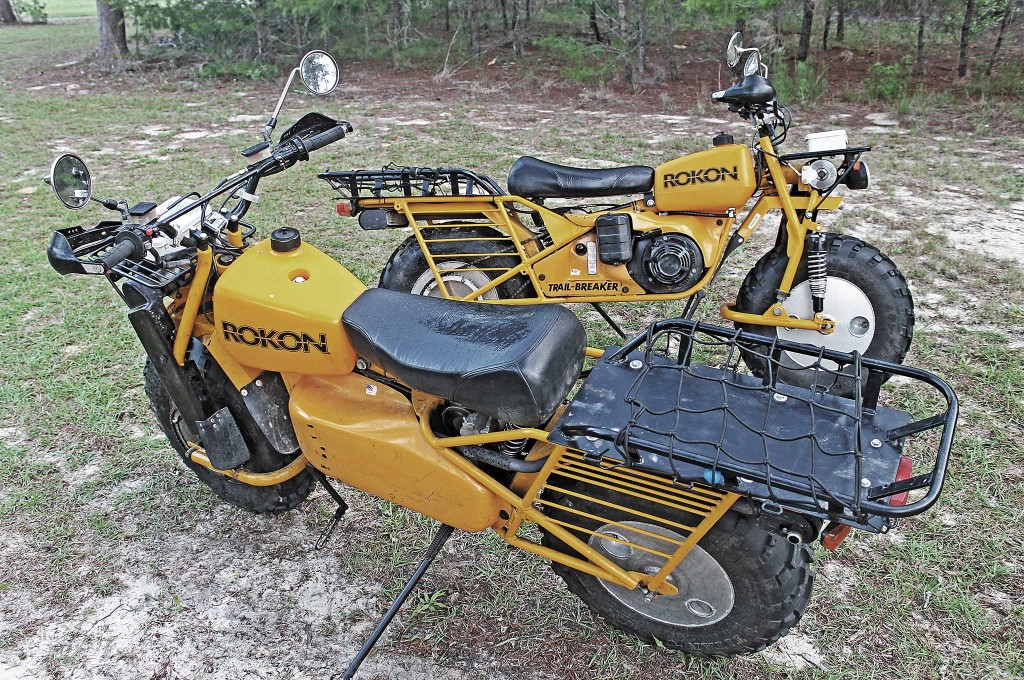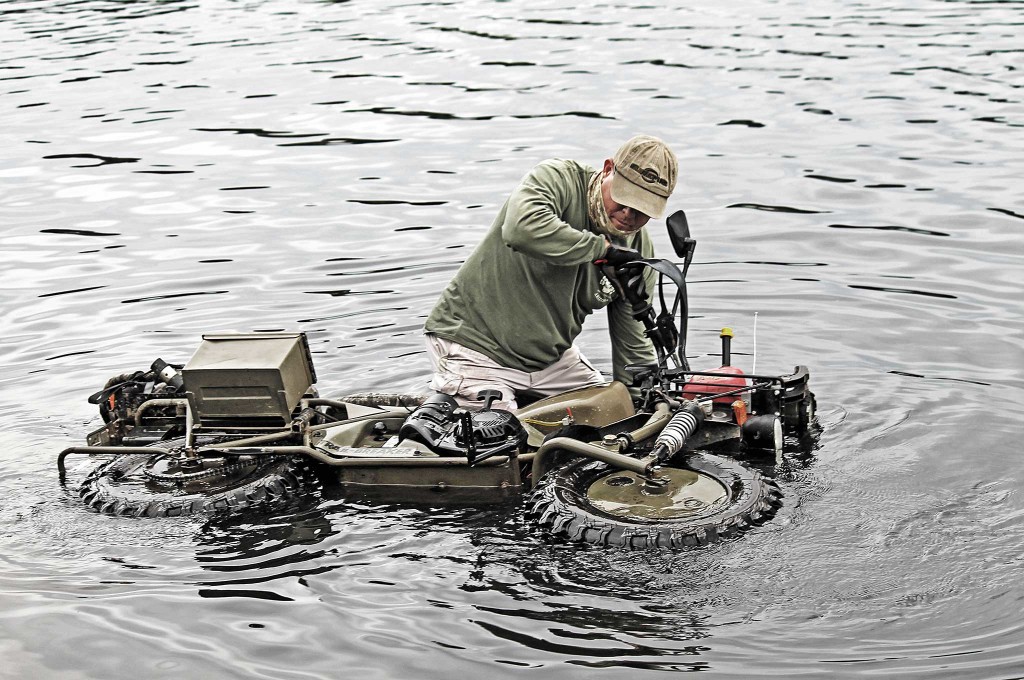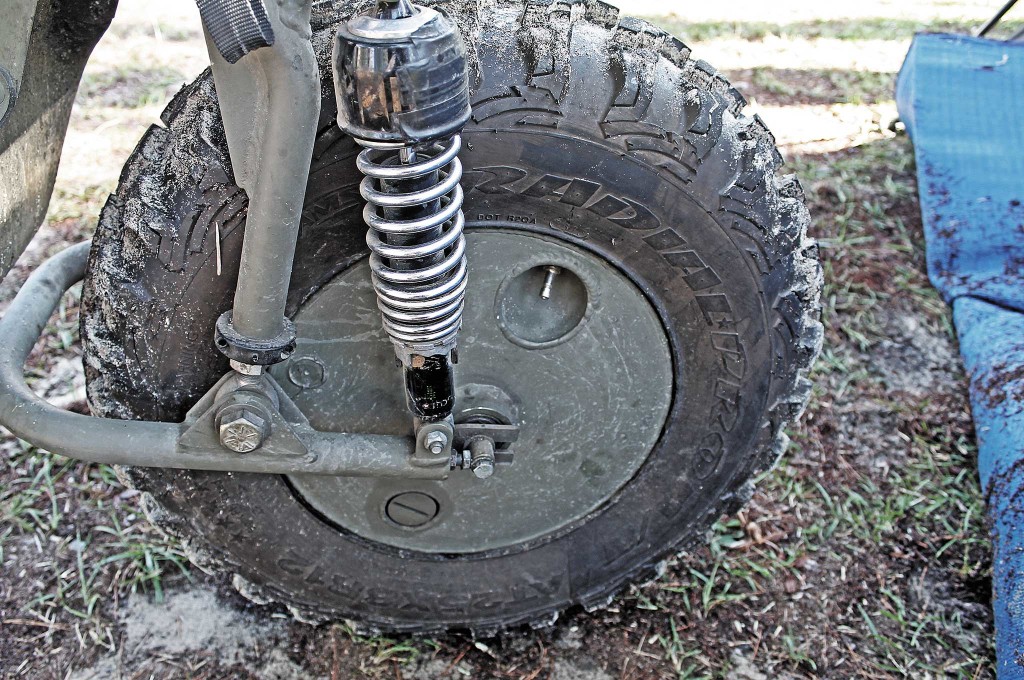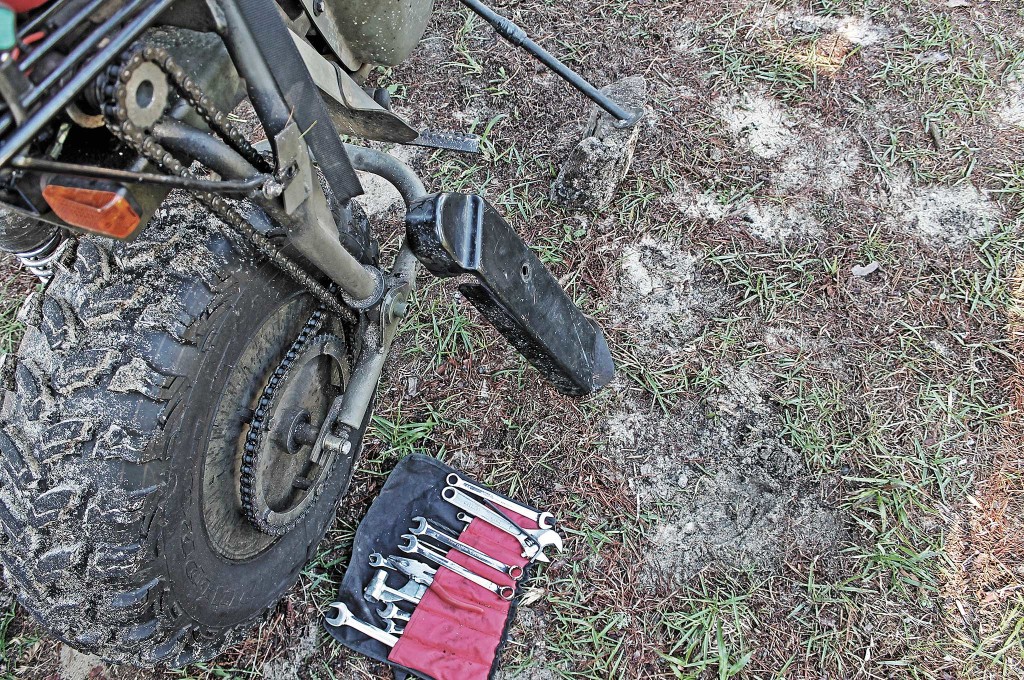RECOIL OFFGRID Transportation Two-Wheel Torque
With one twist of its throttle, the stout Rokon motorcycle can transform from a rubber-burning all-terrain vehicle to a gravity-defying projectile that can down an incoming enemy helicopter, sacrificing its own life to heroically save your entire team from a deadly strafing run. Naturally, this can only be done if you're Sylvester Stallone, your team includes Jason Statham, and the helo is a prop in Expendables 2.
Artistic license aside, its movie-star turn serves to illustrate what its loyalists have believed for nearly 50 years: the Rokon is not only America's best kept secret weapon, but also the ultimate transporter that can practically roll on, over, and through almost everything.
The modern-day Rokon stakes its claim as the second-oldest U.S. motorcycle in constant production. Remaining true to its heritage, today's Rokon closely resembles the simple schematics that inventor Charles Henry Fehn first submitted with his patent applications in 1958 when he called it the Trail-Breaker. The patent was granted in 1966, and even today's models are instantly recognizable as offshoots of the original version, what with the MIG-welded steel frames and tractor-like 8x12x25 Titan tire treads over hollow aluminum drum wheels. In fact, the sealable drum wheels hold 2.6 gallons each of water or fuel, so you could almost triple the amount of fuel available on board from the standard 2.69-gallon fuel tank. Its four-stroke, fan-cooled 7hp Kohler 208cc engine is mated to a three-speed automatic torque-converter transmission.

With a burn rate of 1/4 gallon per hour, and with a running speed of, say, 30 mph, your bug-out-route range will approach 330 miles on one 2.69-gallon tank before you tap into the wheel reservoirs for two additional fill-ups for a total range of over 900 miles. And if things get to Mad Max: Fury Roadlevels of desperation, you can always sling another tank on the back.
And, OK, the Rokon does not fly. But when each wheel drum is left empty, the 218-pound Rokon may be laid on its side and floated across open water, carburetor up. “What good is a floating bike?” you might ask. What if your bug-out route brings you to a deep creek or river and a roadblock is set up at the only bridge crossing for 200 miles? Try wading chest deep with your dual-sport bike or ATV.

A pair of Rokons relied upon by the U.S. Forest Service to hit the trails inaccessible to ATVs and quads.
From his 1915 birth in San Bernardino to his passing in 1972, Fehn lived in Southern California with a penchant for invention and seeking investors, demo-ing the Trail-Breaker in steep sand dunes or by driving over the dropped tailgate and into the bed of his El Camino. Through development of an innovative clutch, front and rear chain-driven wheels, and gearing system, Fehn's ideas enabled the rider to maneuver in tight turns without grounding — a system that has since undergone considerable refinement.
Early bikes were sold in kit form or from various distributors, the most successful being Orla Larsen. Larsen named his distributorship company Rokon, after his Vermont ski lodge that he called “On The Rocks.” While some die-hards still pronounce the motorcycle name “Rock-on,” the universal pronunciation is “Row-con.”
Today the company is enjoying a resurgence as Rokon International, Inc., based in Rochester, New Hampshire, with 29 dealers in the U.S. and eight overseas. Factory-direct custom order sales are strong with Rokons arriving at dealers and doorsteps around the country, said President Tom Blais.
If the Internet's latest “ultimate” bug-out jeep, truck, or tank is beyond your financial reach or free space in your garage, consider adding a Rokon as your bug-out vehicle. For those who have the scratch, it could also serve as a secondary ride mounted on your truck bed or on a trailer hitch. It's available in street legal or strictly off-road versions and is highly customizable from dealer options. Dual-sport bikes fit the higher speed, on-road/on-trail route scenario very well (see RECOIL Issue 10, and OFFGRID Issue 7 or turn to “(No) Easy Rider, our feature on motorbike techniques, elsewhere in this issue). Still, when SHTF, Rokon riders say the low and stable two-wheel-drive difference is unbelievable if you have to leave the urban landscape and go beyond established trails, all the while towing a trailer or dragging big-game behind you.
In a series of real-world tests, we were able to validate the Rokon's billy-goat-meets-Big-Foot qualities by joining a small group of hardcore riders on a 200-mile journey deep within the Ocala National Forest. There the U.S. Forest Service Rangers receive training on the usage of the Rokon for taking chainsaws and other gear deep within trails that are too narrow for ATVs. Rangers favor the low-pressure Rokon tires (3.5 pounds psi) and spark arrestor mufflers in the deep sugar sand, inclines, and muddy crossings. The tubeless tires are said to leave less pressure than a human footprint, passing easily between narrow trees on handlebar-width trails. The bikes also can perform search-and-recovery efforts, even towing out other vehicles with a ball hitch if needed.
“These Rokons are not about speed,” said one of the riders, a retired U.S. Army brigadier general who once demo'd the Rokons for the Pentagon. “These are about torque. These are about getting from Point A to Point B when there is little or no path before you and you must absolutely arrive. They are unstoppable. They will go where a dirt bike, quad, or ATV will not pass.”
Rokons feel very different from traditional dirt and street bikes or ATVs and require a shift in thinking. All Rokon controls are accomplished by the hands. The unsprung, folding front or rear foot pegs serve only to support the rider and passenger's sturdy boots while riding, allowing the riders to place one or both feet on the ground to steady the bike on slow maneuvers and obstacles.
The tractor-like tires and high (14-inch) ground clearance allowed seesaw, teeter-totter log crossings by shifting weight fore and aft. Compared to high-riding dirt bikes, the Rokon's low-seat position inspired confidence while traversing slopes.
Although one novice rider laid his bike down about three times in deep shifting sands, the rider was never thrown and was faulted more than the bike. These were not bunny slopes, and the fact that a beginner could negotiate these hills is a tribute to the bike's low center of gravity and pure torque.
Orientation commences with powerful front and rear hydraulic disc brake levers, with the left hand braking the rear and the throttle hand controlling the front. Both brakes are mounted high to keep them free from mud and water. The left hand also controls a black engine emergency “kill” button that shuts off the engine if the bike goes down, plus headlight switch. Above all, we insist on opting for the “Brush Buster” optional handguards to protect the grips and hands from impacts with trees, rocks, or any other obstacles.
On the lower right-hand side, fuel management is controlled by the fuel tank shutoff valve, for storing or transporting the Rokon. Close by and beneath the choke, an engine fuel valve is opened for riding and closed for storing the motorcycle. The fuel tank cap air valve may be closed to air intake in the event the Rokon is floated sideways — during our test, this was followed by an immediate and sure start. Some early model bikes attending were equipped with snorkels for exceeding the recommended maximum operating depth of 24 inches.
With the engine in neutral, and using the three-position (anti-theft) ignition key switched to on, the Rokon is started either from a steady pull on the right-side starter rope or from an optional key electrical starter.

Testing the Rokon's flotation at lakeside. With carb side up, the Rokon creates a splash, but comes up and starts.
What sets the Rokon apart from other motorcycles is the sealed three-range transmission that appears as a straight shaft inline horizontal plunger on the lower right side of the bike, with a black ball end. Shifting is not done on the move, but from a dead stop and only then at idle speed or when the engine is off. Grasping the plunger ball and pulling outward all the way brings the bike into first gear. If needed, gently rock the bike until the gears synch. The shift pattern from the inside to the outside is as follows: third, neutral, second, neutral, first. There's no reverse. To turn the bike in tight quarters, it may be pivoted 180 degrees on its kickstand.
The Rokon may be started in gear, with one hand lightly on the brake lever and without revving the engine. From any gear, the Rokon may be run from a dead standstill to the top speed range of its gear. When coupled with the automatic torque converter, it has extremely broad capabilities from steep grade climbing to routine routes. The torque converter provides a large overlap of speed and torque between gears, making frequent gear changes unnecessary and eliminating the need to shift on the move. In the event a dangerous encounter occurs, the Rokon may be brought to an abrupt stop, still in gear at idle speed, and hands switched to sidearm or long-gun without downshifting or going to neutral. Even in third, one twist of the throttle later, and you are gone.

Auto-Grab suspension has 8 inches of travel, and the aluminum wheel holds 2.6 gallons of water or fuel.
The torque converter is designed especially for Rokon and provides smooth automatic clutching and ratio changing in response to throttle control and terrain requirements, all without loss of engine revs or power, as the front and rear-driven pulleys transfer power through the gears to the front or rear chain drives.
We crawled and drove up tree trunks and ditches in first, floated through sand in second, and hauled down logging roads in third, although some expert riders never left third and managed the responsive throttle beautifully.

With the front wheel chain guards removed, proper chain tensioning and lubrication is accomplished with simple wrenches.
For many years, riders had only an adjustable seat spring for one or two riders and low-pressure tires to absorb vibrations while covering terrain. More recently Rokon offers a new Auto-Grab front suspension, allowing for 8 inches of shock travel via a swing-arm pivoted at the bottom of the front fork. In order to maintain proper chain tension as the suspension moves, a second chain was added up front on a dual idler sprocket, adding a slight amount of weight and improving traction. Rokon's Geoff Richardson said the front spring was developed at the insistence of the Jordanian military for ease of negotiating asphalt that's pockmarked with mortar rounds. Jordan now imports its own Rokons and assembles them in a plant, where the King of Jordan maintains a Rokon museum.
Maintenance on most items is accomplished with a simple set of wrenches and lube, with many parts available from local hardware stores. Checking for front and rear chain tension and lubrication is standard operating procedure.
A cult-like following of Rokon rebuilders is constantly searching for Rokons to restore and to rally with in remote locations the nation over, while squeezing out an additional 5 to 10 mph. During our ride, accessories were basic, ranging from tomahawks and handheld GPS units to ammo cans that went unopened. To equip and customize a modern Rokon, the company makes it simple for new owners by providing an itemized accessory menu, with a rumored Prepper Edition in all black arriving some day.
Meanwhile, for bugging out and keeping a low profile, we highly recommend accessories, including:
– Trail Maintenance Kit, (fuel filter, air filter, spark plug and wrench, two connecting chain links, two half links and chain, chain breaker, low-pressure gauge, pump, tubeless repair kit, and drive belt in leather pouch
– Camouflage Upgrade
– Carrier ramp plus ratchet straps to secure Rokon to trailer hitch or truck
– Gun boot, saddle style; keeps the width of the bike down and is safer than carrying a rifle across the handlebars on narrow, wooded trails.
– Tow bar kit chain, trailer hitch, and hard bar
– Brush Busters (handguards)
– Tachometer/hour meter
– Game Carrier, which replaces the rear seat to transport backpacks, cargo, rigging saddle bags, and large objects
– Single Track Trailer, a long linear carrier that increases carrying capacity
– GPS/cell phone holders
– Fuel siphon pump
– Waterproof 12-volt plug for recharging cellular phones, lap tops, and powering low-pressure air pump for tires
– Tactical carry system (two ammo cans) on saddle bag position
– Stihl chainsaw, machete, axe, rope, spare fuel, trail maps, tent, pack
The Rokon Trail-Breaker has come a long way from its origins in 1958, one year after some young Americans first carried the M-14 into Vietnam. Just as a new generation of fighters has rediscovered the worth and staying power of the old battle rifle, so too are new generations of “urban bug-out planners” realizing the potential of the Rokon ride.
Our deep wilderness ride ended with one broken mirror, but we're not courting bad luck. As this author tells his firearms students, “Leave luck to the unprepared.” Rock on, Rokon.
Company president Tom Blais pounded the Chilean Andes with his. The U.S. Special Forces covered sands with it in Desert Storm. And U.S. Border Patrol agents use theirs to pursue narrow foot paths. Rokon motorcycles are relied upon by the military and law enforcement agencies all over the world, from Fort Bragg to Brunei.
So, we were thrilled at the chance to join the ranks of those who've tested these all-terrain vehicles. Here are some lessons learned from a recent hardcore training session:
– Starting in neutral is best.
– Carry maps, a GPS unit or two, plus plenty of fuel in reserve.
– Keep a few basic tools with you to tighten up any loose fittings, and always keep your chain properly tensioned and lubricated.
– Practice your bug-out skills by creeping through the woods or your given landscape, walking the bike if necessary. Work less on speed and more on negotiating obstacles.
– If you're unable to avoid traveling on or across roads, keep your head on a swivel, scanning and assessing 360 degrees when traveling and stopping, watching first from the woods and listening before crossing.
Rokon offers three similar models with slight variations in color, available suspension, wheel, and motor-gearing options. Each model is available with 50 factory accessories, from a one-bolt add-on sidecar to a 2,000-watt generator.
Rokon
Trail-Breaker
The flagship bike is the complete package with Auto-Grab front wheel suspension, 12-inch aluminum drums, and the high-output 208cc 7hp Kohler engine.
Drive System Full-time all-wheel drive
Engine 7hp Kohler, one-cylinder, four-stroke
Piston Displacement 208cc Kohler
Power Transmission Auto torque converter into a three-gear range selector
Fuel Tank 2.69 gallon
Grade Capability 60-percent
Wheels 12-inch aluminum sealed drum
Tires 8x12x25 tubeless
Wheelbase 51 inches
Ground Clearance 14 inches
Height Over Seat 32 inches
Height Over Handlebars 41 inches
Width 30 inches
Length 79 inches
Weight 218 pounds (dry weight)
Fordable Water Depth 24 inches
Base Price $7,350
Ranger
The middle-of-the-pack model, appealing to those wanting the 160cc 5hp Honda engine and solid non-drum heavy-spoke wheels.
Drive System Full-time all-wheel drive
Engine 5hp Honda, one-cylinder, four-stroke
Piston Displacement 160cc Honda
Power Transmission Auto torque converter into a three-gear range selector
Fuel Tank 2.69 gallon
Grade Capability 60-percent
Wheels 12-inch steel spoke
Tires 8x12x25 tubeless
Wheelbase 51 inches
Ground Clearance 14 inches
Height Over Seat 32 inches
Height Over Handlebars 41 inches
Width 30 inches
Length 79 inches
Weight 218 pounds (dry weight)
Fordable Water Depth 24 inches
Base Price $6,975
Scout
Basically the same as the Trail-Breaker, only without the drum wheels and the front suspension for a lighter or more traditional feel.
Drive System Full-time all-wheel drive
Engine 7hp Kohler, one-cylinder, four-stroke
Piston Displacement 208cc Kohler
Power Transmission Auto torque converter into a three-gear range selector
Fuel Tank 2.69 gallon
Grade Capability 60-percent
Wheels 12-inch steel spoke
Tires 8x12x25 tubeless
Wheelbase 51 inches
Ground Clearance 14 inches
Height Over Seat 31 inches
Height Over Handlebars 41 inches
Width 30 inches
Length 79 inches
Weight 218 pounds (dry weight)
Fordable Water Depth
24 inches
Base Price $6,500
Rokon
www.rokon.com
 STAY SAFE: Download a Free copy of the OFFGRID Outbreak Issue
STAY SAFE: Download a Free copy of the OFFGRID Outbreak Issue
No Comments